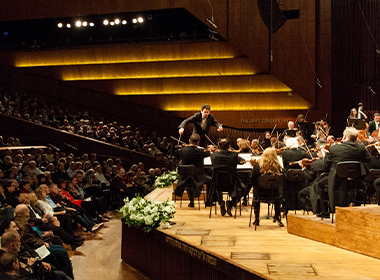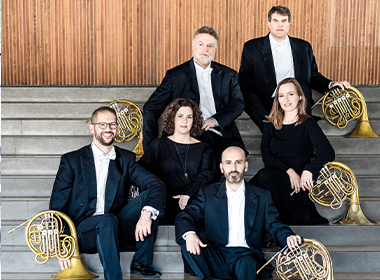Yoel Levi will be conducting Shostakovich‘s Festive Overture, excerpts from Khachaturian’s Spartacus and Gayaneh Suites, in addition to Glière’s popular Harp Concerto, with Chinese harpist YuYing Chen, winner of the 2015 International Harp Contest.
If there is a work that captures the essence of the terror, shock, desperation and hope that the world experienced in the 20th century, a work that is living testimony to the helpless, unnecessary victims of war, it is Benjamin Britten’s War Requiem. This monumental work could be dubbed a “masterpiece”, not only for its musical qualities, but also for the emotion it arouses in listeners, who consider it a horrifying expression of the feelings and frame of mind experienced in the here and now, and whose significance seemingly exceeds the realms of a work of art.
On the title page of the score, Britten quoted the pacifist poet Wilfred Owen, one of the last casualties of the British Army in World War I: “My subject is War and the pity of War. The poetry is in the pity… All a poet can do today is warn.” Britten created a contemporary Passion of sorts, a work that combines traditional texts from the Latin Requiem Mass and poems by Owen that deal with the futility of war and its horrendous outcome. It seems that each component of the work has deep symbolism. Written for the inauguration of the renewed Coventry Cathedral, which was destroyed during the German bombings of World War II, the texts were written by a poet who also gave his life in the war. The soloists chosen to sing in the premiere were carefully picked by Britten: English tenor Peter Pears, German baritone Dietrich Fischer Dieskau and Russian soprano Galina Vishnevskaya (who was not allowed to leave the USSR for the premiere and was replaced by Heather Harper, but later sang in the “ultimate” recording of the work in 1963, with Britten conducting).
One must remember that the War Requiem is primarily a superb musical work, and one cannot attribute its unprecedented success among performers, critics and audiences around the world merely to the relevance of the subjects with which it dealt. Britten, a skilled opera composer, created here a dramatic musical language, whose music covers a vast expressive range: from the whispers of angels, through grief over the victims, helplessness and rage over the pointlessness of war, to acceptance and yearning for peace and calm following the horrors. Britten’s ability to write wonderful melodies, which freely alternate between modality and tonal expansion; his use of basically traditional harmonic language; the orchestration, which is both functional (supporting the singing) and spectacular; his gift in creating sonorous and textural variety, thus not tiring the listener throughout this extensive work – these qualities have made the War Requiem one of the most successful and popular works of the 20th century.
Britten divided the performing forces on stage into three groups. Owen’s texts are sung by the tenor and baritone, accompanied by a small chamber orchestra, creating an intimate atmosphere, resembling a dramatic, chamber-like discussion. At the premiere of the work, in which Britten himself conducted the small orchestra, he stopped conducting at certain points, thus allowing the performers to listen to each other more attentively and to emphasize the text. Performances with two singers who specialized in the Art Song, such as Pears and Fischer-Dieskau, created a performing tradition and set an especially high standard. The texts from the traditional Requiem are performed by the soprano, a large choir and a vast symphony orchestra. The third group of performers is the children’s choir (situated in many performances on stage), singing a kind of religious, angelic “interpretation”, accompanied by an organ. Britten, a master of setting words to music, wrote a work in which the music leads the text, while also embellishing it. The movements of rage and terror about the Dies irae (“Day of Wrath”) are interspersed with the gruesome text about Isaac’s sacrifice, which, in Owen’s hands, becomes a horrifying allegory, in which even the cry of the Lord to Abraham, “Lay not thine hand upon the lad” does not stop the knife from slaying “half the seed of Europe one by one”. The lamenting Latin text, Agnus Dei (“Lamb of God”), is set against Owen’s poem (in an asymmetrical rhythm of five sixteenth notes), in which the tenor sings of a statue of Jesus, situated on a crossroads, whose arm was severed during the war. The heart-wrenching Lacrimosa, sung by the soprano with choir and orchestra, combines with a chilling lament and the cry of a soldier leaning over the body of his dead friend, “Was it for this the clay grew tall?”
The War Requiem clearly follows with the tradition of the Requiem in musical history. Britten’s Dies irae overtly resembles the Dies irae of Verdi’s Requiem, the Lacrimosa shares the lyricism and accompanimental textures of the corresponding movement of Mozart’s Requiem, and the Gregorian qualities of the music sung by the children’s choir in “Seraphim of Heaven” imply that Britten, in his way, wished to suggest that even centuries of Requiems have not managed to prevent the horrors of war that the world has known. In this sense, Owen’s warning and Britten’s music are more relevant to our times than ever.
Shostakovich was loyal to his homeland Russia all his life and apparently also to socialism according to Soviet ideology. Therefore, in 1954 he accepted an official commission for an orchestral work honoring the 37th anniversary of the October revolution. He completed the Festive Overture in one day, and it was premiered on 6 November of that year, with the orchestra of the Bolshoi Theatre in Moscow under Alexander Melik-Pashaev. A few weeks earlier, Shostakovich had been nominated Music Adviser of this theatre.
This work does not glorify the regime and has no testimony of submission, adaption, conciliation or willingness to cooperate with the Soviet propaganda on the part of the composer. As was his way, Shostakovich managed to express faith and genuine feelings in his music, yet could not be accused of taking a clear stand. In principle, he was adamantly opposed to tyranny and oppression.
Does this lively and joyous overture have any political implications at all? March 1953 saw the death of Stalin, who with his colleagues, humiliated the composer and tried to ban him. Even after the tyrant‘s death, Shostakovich‘s suffering and public humiliations did not come to an end, and the anxiety, the suspicious, the constant following and financial problems continued. That same year he wrote thhe great Tenth Symphony, which is considered a tragic testimony, saturated with pain and anger, meant to condem the oppressor for posterity.
A diligent and fast writer, at that same time Shostakovich also composed chamber music, songs and works for choir, music for the cinema and for Shakespeare‘s Hamlet.
The Festive Overture, a carefree and joyous work, is a gush of graciousness and optimism. This is an ”innocent” work, lacking any irony, direct and exciting, brilliantly orchestrated. Some find in it more than triumphant fanfares for the human spirit; a vigorous reminder of the composer‘s multi-faceted and controversial musical personality. Others see in it joy and happiness anticipating a new era, which will bring liberty and respect to the creator and to the common man. Throughout the years, this modest work has been recorded and also arranged for wind ensembles. It is suitable for concert halls all over the world, not only in the Russian capital for official ceremonies and events.
Glière: Harp Concerto
A contemporary listener is accustomed to identifying twentieth-century Russian music with personal and artistic struggles of composers, who fought for their personal and artistic freedom. Reinhold Glière’s biography could have been taken from the book, “Who is the Worthy and Honest Russian Composer”. Born in Kiev in 1874 to a family of Belgian descent, he studied with the most celebrated composers at the Moscow Conservatory, including Arensky, Taneyev and Ippolitov-Ivanov. He researched the folklore of Azerbaijan, Uzbekistan and Ukraine, documenting and arranging folk music, and in 1920 settled in Moscow, eventually teaching at the Conservatory in which he had studied. In a scholarly essay on Glière, written by hornist Valeriy Polekh, he also mentions that Glière was very handsome. In all respects, a perfect composer. His music is characterized by post-folkloristic ideas, with an emphasis on lyricism and rich harmonic colors, leaning on the traditions of the Romantic period. It is therefore not surprising that he was highly respected in Tsarist Russia, as well as in the Communist regime, and was part of the “official” musical core of the USSR. Today he is known primarily for his Third Symphony (“Ilya Muromets”), his ballet “The Red Poppy” and the Harp Concerto. He composed this work in 1938 for Ksenia Erdely, Principal Harpist of the Bolshoi Theater and the first musician to play harp concertos in Russia. Glière consulted with Erdely (which greatly contributed to the fact that the work is considered idiomatic for this instrument), and eventually even proposed she be credited as co-composer. Erdely graciously declined, but is credited in the score as “Editor”. Glière’s concerto is an example of truly anachronistic music and the listener will find it hard to believe that it was written in 1938 and that its composer is not Tchaikovsky. There is nothing wrong with this – good conventional music is good conventional music. Due to the combination of idiomatic writing, pleasant melodies, effective orchestration, in addition to the lack of good pieces for the instrument, this concerto has been frequently performed since its premiere.
Khachaturian: Excerpts from Spartacus and Gayaneh Suites
Ballet music was always a paradise for melodists. The need and ability to write pieces that have a framed structure, are mostly short and in dialogue with movement or with a stage production, was fertile grounds for composers, who wrote works that later became staples of programs of “musical hits”. Parts of Spartacus by Khachaturian will probably be familiar to concert goers, as well as to lovers of artistic ice skating (music from the ballet suite was used by ice skater Ashley Wagner when she won the US Championship in 2015), or to British television fans, who still remember the opening theme of the BBC’s Onedin Line. A less familiar fact, perhaps, is that even before the first performance of the ballet, the musical score received the Lenin Prize in 1954. The work was performed on the stages of the Bolshoi in Moscow and the Kirov Theater in Leningrad. The 1968 version of the ballet is the one performed by the Bolshoi to this day. The story is of Spartacus, who leads the slave mutiny against the imperialist Romans. Khachaturian used this basic plot to create a colorful work, filled with heroic music and graceful, passionate dances. As in all of Khachaturian’s works, this ballet also has thematic metamorphoses, which come from folkloric culture, perhaps influenced by the varied music of his native Armenia. The melodic charm, wonderful orchestration and sweeping rhythms made each of the Spartacus suites a favorite in concert venues, even if there are no dancing slaves and ballerinas.
Khachaturian wrote national music, with extended use of folk material (which might have stemmed, to some extent, from the fact that he lived and worked in Stalinist USSR). His works brim with folksongs of his native Armenia, and are also influenced by old folklore of various peoples of the USSR, such as Caucasia and Aremnia‘s other neighbors. All this is cast in the liveliness typical of the first half of the 20th century, when the various ”modernistic” schools were not yet widespread, certainly not in Stalinist USSR.
In 1942, during World War II, he was commissioned to write the music for a ballet, Gayaneh. The music was immensely successful and Khachaturian was awarded the Stalin Prize for it (in 1939 he had already received the prestigious Lenin Prize).
Gayaneh is a female member of an Armenian Kolkhoz (communal settlement), whose drunkard husband betrays her and joins a group of bandits. He attempts to set fire to the Kolkhoz and to murder his wife, but the commander of the local unit of the Red Army captures the bandits and saves the Kolkhoz. Gayaneh and the commander fall in love and marry at the inevitable happy end.
The orchestration is rich and colourful, and includes an alto-saxophone, harp, piano and an extended percussion section in a multitude of effervescent dance-rhythms. Some of the pieces have become staples of light concert-music, such as the Sabre Dance. Three orchestral suites were arranged of the ballet music.
The concerts take place as part of the 60th anniversary celebration of the international harp competition in Israel
Text: Prof. Oded Zeavi, Israel Daliot, Orly Tal
Program no. 1
Yoel Levi, conductor
Tatiana Pavlovskaya, soprano
Jamez McCorkle, tenor
Morgan Pearse, baritone
The Gary Bertini Israeli Choir, directed by Ronen Borshevsky
The Joshua Tuttnauer Ankor Choir of the Jerusalem Academy of Music and Dance directed by Dafna Ben Yohanan
Bat Shir Choir of the the Haifa Symphony Orchestra,
directed by Tali Weisman
Britten: War Requiem








 Back to top
Back to top




